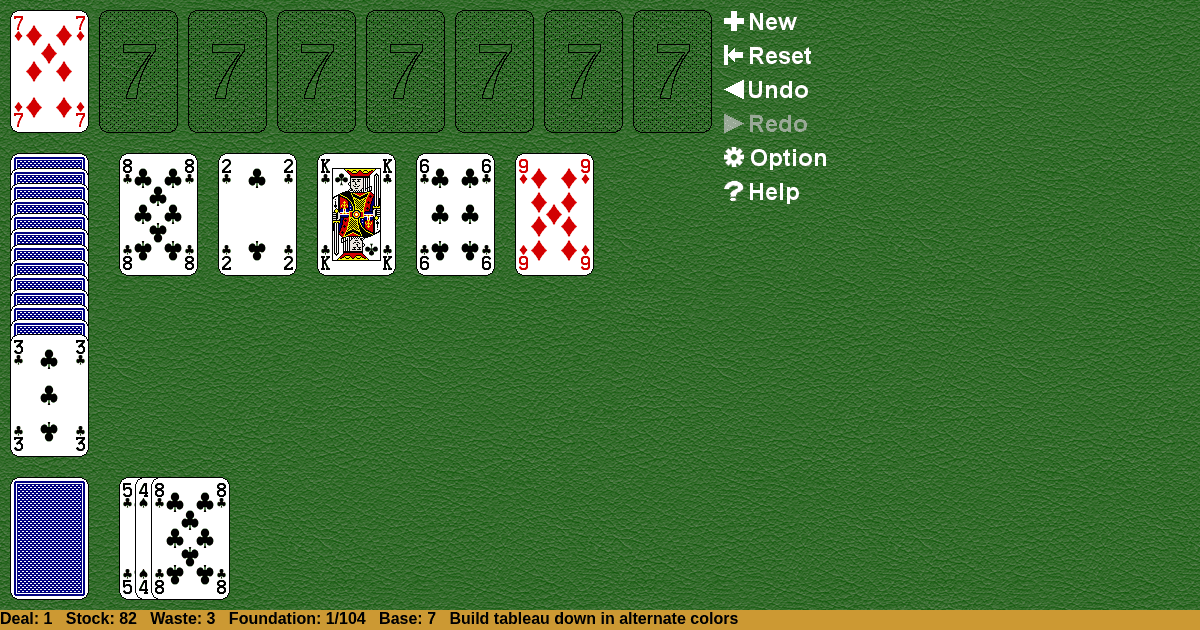Double Canfield
Home |
How to play |
FAQ |
About
How to play Double Canfield?
Game Objective:
The primary goal in Double Canfield Solitaire is to move all 104 cards (two standard decks) to the eight foundation piles, building each foundation up in suit from a variable starting rank until each pile contains thirteen cards.
Setup & Layout:
- Deck: Use two standard 52-card decks (total 104 cards).
- Foundations: Eight piles. The first foundation card is dealt from the stock; its rank sets the base for all foundations. Foundations are built up in suit, wrapping from King to Ace if necessary.
- Tableau: Five columns, each dealt one card face up. Cards in the tableau are built down in alternating colors. The top card of each column is available for play.
- Reserve: Thirteen cards are dealt face up in a single pile, with only the top card available for play.
- Stock: The remaining cards form the stock pile, which is used to replenish the waste.
- Waste: Cards from the stock are dealt (typically three at a time) to the waste pile; only the top card of the waste is available for play.
Key Play Areas:
- Foundations: Eight piles to be built up in suit from the base rank.
- Tableau: Five columns built down in alternating color.
- Reserve: One pile of 13 cards, only the top card playable.
- Stock: Draw pile for replenishing the waste.
- Waste: Discard pile; only the top card is playable.
Double Canfield Solitaire Rules:
- Foundations:
- Built up in suit, starting from the base card (first dealt foundation card) and wrapping from King to Ace as needed.
- Example: If the base card is a 3, the sequence is 3, 4, 5, …, King, Ace, 2.
- Only cards matching the next required rank and suit may be placed.
- Once a card is placed on a foundation, it cannot be moved.
- Tableau:
- Built down in alternating colors (red on black or black on red).
- Wrapping is allowed: Kings can be placed on Aces and vice versa.
- Only the top card of each tableau pile is available for play.
- Entire sequences built down in alternating colors can be moved as a unit; partial sequences cannot.
- Reserve:
- Only the top card is available for play to either the tableau or the foundations.
- Stock & Waste:
- Cards are dealt from the stock to the waste pile, usually three at a time (some versions allow one at a time).
- Only the top card of the waste is available for play.
- Unlimited redeals: when the stock is exhausted, the waste is turned over to form a new stock.
- Empty Spaces:
- Empty tableau columns are immediately filled by the top card of the reserve.
- Once the reserve is empty, empty tableau spaces may be filled by the top card of the waste or, in some versions, by any card or valid sequence.
Gameplay:
- Typical Sequence of Actions:
- Move available cards (from tableau, reserve, or waste) onto foundations if possible.
- Build tableau columns down in alternating colors, moving either single cards or valid sequences.
- Move the top card from the reserve to the tableau or foundations as needed.
- When no moves are available, deal three cards from the stock to the waste pile.
- Continue playing cards from the waste as they become available.
- Introducing New Cards:
- When a tableau column is emptied, it is immediately filled by the top card of the reserve. If the reserve is depleted, fill the space from the waste pile or, in some rulesets, with any card or valid sequence.
- No More Legal Moves:
- If no moves are possible and the stock is exhausted, the game is blocked and considered lost.
Winning & Losing Conditions:
- Winning Condition:
- The game is won when all 104 cards are moved to the eight foundation piles, each built up in suit from the base card to complete a full sequence of thirteen cards.
- Losing/Unwinnable Condition:
- The game is lost if no legal moves remain and all cards cannot be moved to the foundations, even after all possible redeals of the stock.
Special Rules & Edge Cases:
- Filling Empty Tableau Spaces:
- Always fill an empty tableau space with the top card of the reserve, if available.
- If the reserve is empty, fill the space with the top card of the waste pile or, depending on the ruleset, with any card or valid sequence.
- Sequence Movement:
- Only entire sequences built down in alternating colors may be moved as a unit; partial sequences cannot be split and moved.
- Foundation Wrapping:
- Both the foundations and tableau allow wrapping: Aces can follow Kings and Kings can follow Aces as appropriate for building sequences.
- Stock Dealing:
- Cards from the stock are typically dealt three at a time to the waste, but some versions allow a one-at-a-time deal for easier play.
- Unlimited redeals are permitted; the waste can be recycled into the stock as many times as needed.
- Base Card Determination:
- The first foundation card dealt sets the base rank for all eight foundations; all foundations must be built starting from this rank.
This ruleset reflects the most widely accepted and referenced version of Double Canfield Solitaire. Always consult the specific implementation or rulebook for minor variations.

Solitaire Collection
About Double Canfield
Rate (Double Canfield)
4.7 / 5
1,916 votes



























































